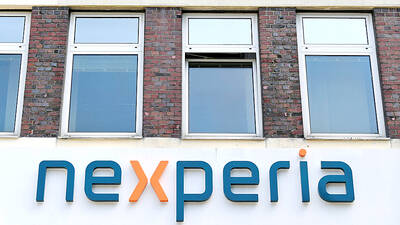A proposal by Democratic lawmakers in the US House of Representatives to give union-made electric vehicles (EVs) higher subsidies drew criticism from non-unionized automakers, including Toyota Motor Corp, Tesla Inc and Rivian Automotive Inc.
Under the 10-year proposal unveiled late on Friday, union-built electric vehicles are to get an additional US$4,500 tax incentive, a measure that would favor the three traditional Detroit automakers — General Motors Co (GM), Ford Motor Co and Stellantis NV — whose factory workers are represented by the United Auto Workers (UAW).
That sweetener would be on top of a US$7,500 base incentive that would be available for electric vehicles.

Photo: EPA-EFE
The draft discriminates “against American autoworkers based on their choice not to unionize,” Toyota said in a statement on Saturday. “We will also fight to focus taxpayer dollars on making all electrified vehicles accessible for American consumers.”
Tesla chief executive officer Elon Musk said on Twitter that the proposal smacked of being heavily influenced by the UAW, while Honda Motor Co also said it discriminatory and urged the US Congress to remove the language.
Rivian, the electric-truck maker backed by Amazon.com Inc, said the expansion of the tax credit is a “step in the right direction,” but that the proposal “risks confusing” potential buyers.
“Rivian supports a straightforward expansion without artificial limits to encourage EV adoption to as many households as possible,” the Irvine, California-based start-up, whose electric pickup truck is not yet available for sale, said in a statement on Sunday.
Foreign automakers and other non-unionized automakers have been voicing their unease with signs that the administration of US President Joe Biden wants to give their unionized Detroit rivals a leg up in the race to win over electric vehicle buyers.
Toyota, Honda, and Tesla were all left out of a White House event last month, during which Biden unveiled a national goal of having half of new vehicles sold in the US to be emissions-free by 2030.
The US House of Representatives Ways and Means Committee’s plan would provide a base credit of US$7,500 for electric vehicles for the first five years, with another US$4,500 credit for those made in a union facility. An additional US$500 credit would be provided for vehicles using a domestically manufactured battery.
The proposal was for inclusion in Democrats’ US$3.5 trillion tax and spending legislation, said US Representative Dan Kildee, a Michigan Democrat.
Additional details from the committee’s plan include elimination of the current cap of 200,000 vehicle per manufacturer for tax credit, a decision that would help GM and Tesla.
Credit would only apply to vehicles that have a manufacturer’s suggested retail price of less than US$55,000 for a car, US$64,000 for a van, US$69,000 for a sports utility vehicle and US$74,000 for a pickup truck, the plan says.
Credit would have annual income limitation of US$400,000 for an individual, US$600,000 for heads of household and US$800,000 for couples, and starting in 2027, the US$7,500 base credit would apply only to electric vehicles built in the US, according to the plan.
While Tesla — the biggest seller of electric vehicles in the US — would benefit by having the 200,000-vehicle cap removed, it, too, is a non-union shop and as such its customers would miss out on the sweetener.
Musk, in his Twitter post, said the proposal smacked of being heavily influenced by the UAW and by Ford, which for now builds its only electric vehicle — the Mustang Mach-E — in Mexico. Foreign-built electric vehicles sold in the US are eligible for the credit in the first five years.
Ford’s battery-powered F-150 Lightning is to be built at a new factory in Dearborn, Michigan, that Biden visited in May. The Lightning is scheduled to go on sale next spring.

Jensen Huang (黃仁勳), founder and CEO of US-based artificial intelligence chip designer Nvidia Corp and Taiwan Semiconductor Manufacturing Co (TSMC, 台積電) on Friday celebrated the first Nvidia Blackwell wafer produced on US soil. Huang visited TSMC’s advanced wafer fab in the US state of Arizona and joined the Taiwanese chipmaker’s executives to witness the efforts to “build the infrastructure that powers the world’s AI factories, right here in America,” Nvidia said in a statement. At the event, Huang joined Y.L. Wang (王英郎), vice president of operations at TSMC, in signing their names on the Blackwell wafer to

AI BOOST: Although Taiwan’s reliance on Chinese rare earth elements is limited, it could face indirect impacts from supply issues and price volatility, an economist said DBS Bank Ltd (星展銀行) has sharply raised its forecast for Taiwan’s economic growth this year to 5.6 percent, citing stronger-than-expected exports and investment linked to artificial intelligence (AI), as it said that the current momentum could peak soon. The acceleration of the global AI race has fueled a surge in Taiwan’s AI-related capital spending and exports of information and communications technology (ICT) products, which have been key drivers of growth this year. “We have revised our GDP forecast for Taiwan upward to 5.6 percent from 4 percent, an upgrade that mainly reflects stronger-than-expected AI-related exports and investment in the third

RARE EARTHS: The call between the US Treasury Secretary and his Chinese counterpart came as Washington sought to rally G7 partners in response to China’s export controls China and the US on Saturday agreed to conduct another round of trade negotiations in the coming week, as the world’s two biggest economies seek to avoid another damaging tit-for-tat tariff battle. Beijing last week announced sweeping controls on the critical rare earths industry, prompting US President Donald Trump to threaten 100 percent tariffs on imports from China in retaliation. Trump had also threatened to cancel his expected meeting with Chinese President Xi Jinping (習近平) in South Korea later this month on the sidelines of the APEC summit. In the latest indication of efforts to resolve their dispute, Chinese state media reported that

CHINESE EXPORT CURBS: A dispute between China and the Netherlands could halt chip supply, affecting vehicle production, US and European auto associations said Groups representing major automakers late on Thursday warned that a chip disruption stemming from a dispute between China and the Dutch government could quickly affect US auto production. Automakers and their suppliers received notice from chipmaker Nexperia (安世半導體) last week that it could no longer guarantee delivery of its chips, the European Automobile Manufacturers Association said, adding that manufacturing could be significantly disrupted. In the US, the Alliance for Automotive Innovation, which represents General Motors, Toyota, Ford, Volkswagen, Hyundai and nearly all other major automakers, urged a quick resolution. “If the shipment of automotive chips doesn’t resume — quickly — it’s going to